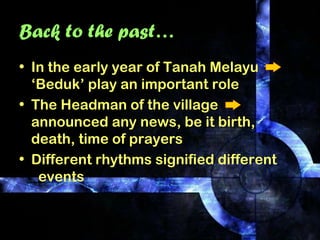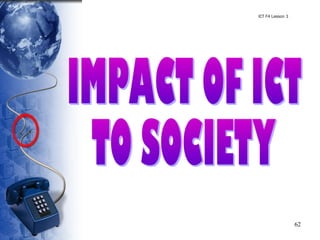Intro to ict
- 1. 1 ICT F4 Lesson 1
- 2. 2 How our ancestor used to disperse information to others? ICT F4 Lesson 1
- 3. 3 Back to the past… • In the early year of Tanah Melayu ‘Beduk’ play an important role • The Headman of the village announced any news, be it birth, death, time of prayers • Different rhythms signified different events
- 4. 4
- 5. 5
- 6. 6 • ICT is the technology required for information processing • use of electronic computers, communication devices and software applications • convert, store, protect, process, transmit and retrieve information What is ICT?
- 7. 7 Information knowledge obtained from reading, investigation, study or research telephone, television and radio to make decisions and to predict the future knowledge and helps us to fulfill our daily tasks
- 8. 8 Communication • an act of transmitting messages • a process whereby information is exchanged between individuals using symbols, signs or verbal interactions • internet, e-mail or video conferencing How did people beforeus communicate?
- 9. 9 Technology • the use of scientific knowledge, experience and resources to create processes and product that fulfill human needs • Aiding Communication - telephone and fax machines are used in extending communication • Spreading Information – To broadcast information such as news or weather reports effectively (Radio, television, satellites and the world wide web (www))
- 10. 10 3500BCSumerians created cuneiform writing 1500BCPhoenicians developed the alphabet Timeline for the development of technology
- 11. 11 105 BC Tsai Lun of China invented paper 1454 printing machine
- 14. 14 1963communication satellite 1969 first Internet (ARPANET)
- 17. ICT the technology required for information processing, in particular, the use electronics computers, communication devices and application software to convert, store, protect, process, transmit and retrieve information from anywhere, anytime
- 18. 18 Evolution of Computer ICT F4 Lesson 2
- 19. The early years First generation Second generation Fifth generation Third generation Fourth generation New era generation
- 20. 20 First generation (1940-1956) • Vacuum tubes was introduced an electronic tube made of glass used as computer components to store and process data • ENIAC (Electronic Numerical Integrator and Computer) use vacuum tube instead of mechanical switches of the MARK 1 • 1951 UNIVAC (Universal Automatic Computer) which could calculate at the rate of 10,000 addition per seconds
- 21. 21 Presper Eckert Willian Mauchly MARK 1 Vacume Tube ENIAC
- 22. 22 • New technology were needed in the invention of technology a) Vacuum tube – an electronic tube about the size of light bulbs. It was used as the internal computer components. Thousands of them were used b) Punched card – used to store data c) Magnetic tape – introduced in 1957. It is used to store data. A faster and more compact method of storing data
- 24. 24 Problems: • The vacuum tubes generated great deal of heat causing many problems in temperature regulation and climate control • The tubes burnt out frequently
- 26. 26 TRANSISTOR The advantages of transistor: 1. Smaller than vacuum tubes 2. Need no warm up time 3. Consumed less energy 4. Generated much less heat 5. Faster 6. More reliable a small devices use to transfer electronic signal across a resistor
- 27. 27 Third Generation (1964 - 1971) - IBM 370 series were introduced in 1964 - Silicone chip were manufactured in 1961 at the silicone valley - Integrated circuit (IC) technology reduced the size and cost of computers. It is a complete electronic circuit or a small chip of silicone = semiconductor - IC reliable, compact and cheaper than transistors
- 30. 30 Advantages: • Silicone chips were reliable, compact and cheaper • Sold hardware and software separately which created the software industry Software technology: • More sophisticated • Several programs run at the same time • Sharing computer resources • Support interactive processing third generations
- 31. 31 Fourth Generation (1971 – Present) • 1971, Intel created first microprocessor • 1976, Steve Jobs built the first Apple computer • 1981, IBM introduced its first personal computer • Hardware technology: - Silicone chip - Microprocessor - Storage devices • Apple Macintosh • IBM • DELL • ACER
- 32. 33 Advantages: • 100 times smaller than ENIAC (the first computer) • Faster • Reliable • Greater storage capacity • Personal and software industry boomed Fourth generations
- 35. 36 Fifth generation (present and beyond) • Technologically advance • Still being development to become more efficient • Inventions of new hardware technology have grown rapidly
- 36. 37 New hardware technology: • Silicone chips • Processor • Robotics • Virtual reality • Intelligent system • Programs which translate languages
- 39. 40 Anymore questions so far? NO?? ThenIhave question foryou… Describe the brief evolutionof computer
- 40. 41
- 41. 42 1st generation (1940-1956) • Vacuum tubes an electronic tube made of glass used as computer components to store and process data • ENIAC and UNIAC were invented 2nd generation computers (1956-1963) • Transistors small devices that transfer electronic signal across resistor • Transistor is faster, cheaper and smaller than vacuum tubes
- 42. 43 3rd generation (1964-1971) • Integrated circuits (IC) replaced transistor • An IC a complete electronic circuit on a small chip made of silicone • Reliable, compact and cheaper than transistors 4th generation (1971-present) • Microprocessor by Intel specialized chip developed for computer memory and logic • Computer is 100 times smaller than ENIAC
- 43. 44 5th generation computer (present – beyond) • Based on artificial intelligence • Still in development though there are some applications such as voice recognition that are being used today New Era (after 5th gen and beyond) • Technology of computer has become more advanced, modern and sophisticated • Expert system (teleconferencing and speech- recognition system) have been invented as part of modern world communication tools • Supercomputers, mainframes, PC, mobile comp
- 44. 45 Usage Of ICT in DailyUsage Of ICT in Daily LifeLife Computer plays major roles in our daily lives. We need computers to assists us in completing various tasks and jobs Can you list down the usage of ICT in these fields: 1) Education 2) Banking 3) Industry 4) Business
- 45. 46 Computer is used in education sector because they can offer :- enhanced learning cognitive development interactive experiences Education
- 46. 47 Education Teacher - Teacher uses computers to research for teaching materials, participate in online forums and online conferences as well as to aid their teaching Students – As a reference tool. - Browse the internet to look for information Researchers – Collect and process data School administrators- For administrative purposes to make sure that the entire operations runs smoothly
- 47. 48 Banking Customers – Transactions at the 24 hour service centers or via online. Allowed them to do transaction at anytime they want. Businessmen – save their time by using the online services offered by banks Bank administrators – oversee the entire banking activities such as reconciliations, inter-branch transaction (IBT), telegraphic transfer and others by referring to the banking system
- 48. 49 Industry Workers, Researchers – Analyze and collect research data for future reference. Administrators – Oversee the entire operations in the plant or factory to detect specific errors or defects that occurred in the process.
- 49. 50 Business Customers – Connected online with suppliers to purchase products Suppliers – Keep track of their transactions. All products are bar coded and can be read by the computer scanner to help in determining prices and managing inventory. Employees – Communicate with their customers for any enquiries. The system helps employees to get the latest updates on inventory to be informed to the customers
- 50. 51
- 51. 52 ICT F4 Lesson 1
- 52. 53 COMPUTERISED & NON-COMPUTERISED SYSTEM
- 53. 54 COMPUTERISED & NON-COMPUTERISED SYSTEM
- 54. 55 The evolution of man and machine happened hundreds of years ago Computerised system happened only less than a century ago Many tasks can now be accomplished easily via the computerised system
- 55. 56 Education before ICT Education with ICT Not Interactive / Boring Interactive Ordinary teaching and learning Enhance teaching and learning Teacher centered Student centered Teaching and learning must be in one to one ( face to face ) Not necessary ( e.g. video conference, yahoo video massager )
- 56. 57 Banking before ICT Banking after ICT Banking was done manually by taking deposits directly All transactions are done by computers Transactions can only be made during working hour Transaction can be done at anytime and place. Takes time to approve any loan applications Online services, phone banking system, credit cards are available
- 57. 58 Industry before ICT Industry after ICT Industry was slow because everything was done manually and totally depended on human labor Computers and telecommunications industry became very popular and profitable since production can be increased through an all day operator
- 58. 59 Commerce before ICT Commerce after ICT Using the barter system and it was then later developed into currency. E-commerce. It includes distribution, buying, selling and servicing products that are done electronically. Advertisement was in the form of word of mouth, billboards and printed flyers. Trading globally was extremely slow, late and expensive. Traders had to find ways to market global products in the global market.
- 59. 60 The differences between computerized and non-computerized systems COMPUTERIZED • All banking activities are done by using computer system • Transaction can be done anywhere and anytime • It takes shorten time for any banking process • More productive. NON-COMPUTERIZED • All banking activities were done manually • Transaction can only be made during working hours • It takes long time for any banking process • Less productive
- 60. • Two disadvantages using ICT in banking – Fraud – Fully depend on ICT equipment – system / network down – transaction terminated
- 61. 62 ICT F4 Lesson 1
- 62. 63
- 65. 71 State the impact of ICT on society Test your memory…
- 66. 72 Q3 Positive impacts • Faster communication speed • Lower communication cost • Can share opinions and information • Paperless environment • Information and communication borderless through internet Negative impacts • Courage people to access pornography and violence web sites • Can harm uses for long hours used

































































